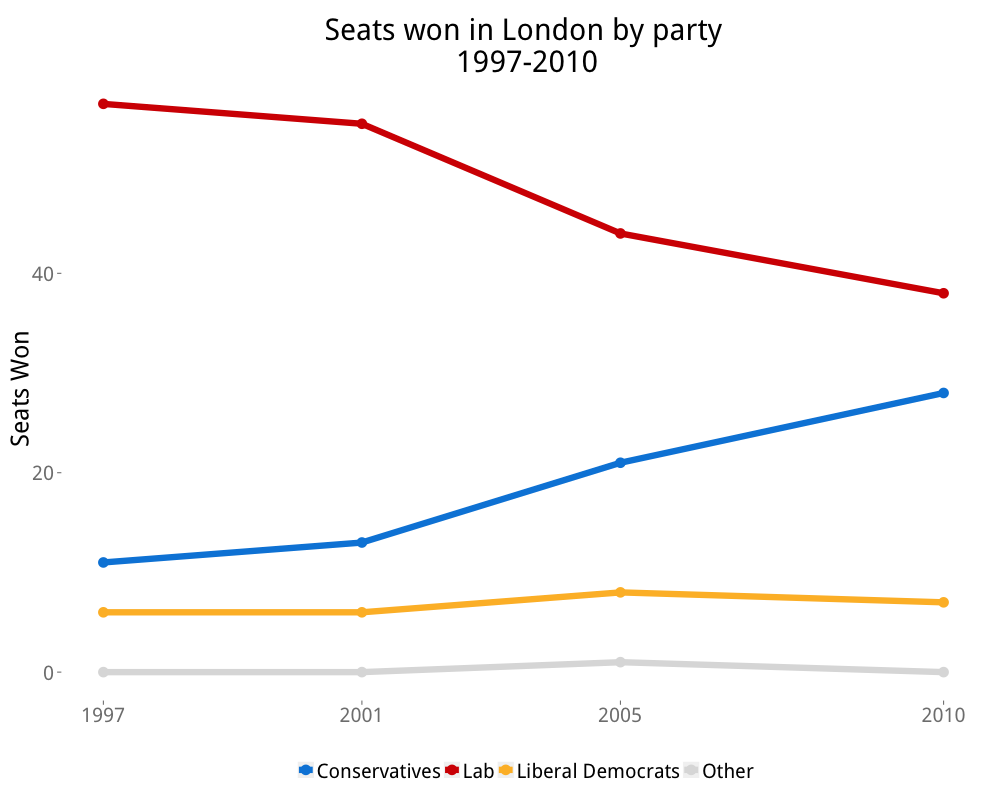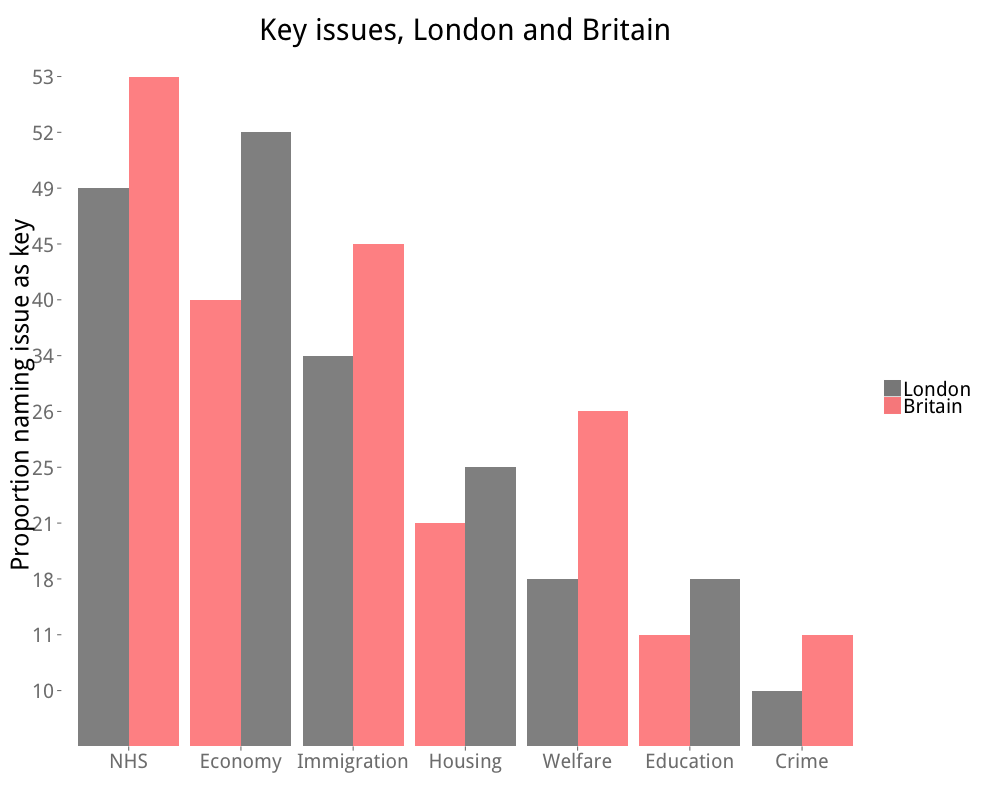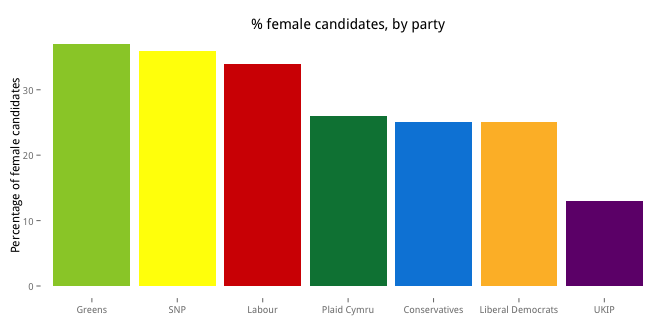 Throughout the short campaign, this blog will be publishing a series of posts that focus on each of the electoral regions in the UK. In this post, Tony Travers discusses the key things to look out for in London.
Throughout the short campaign, this blog will be publishing a series of posts that focus on each of the electoral regions in the UK. In this post, Tony Travers discusses the key things to look out for in London.
See electionforecast.co.uk’s predictions for London here.
London has more MPs (73) than any other UK region except the South East and, despite its unique social and demographic make-up, has remained a broadly straightforward Conservative/Labour battleground. In the 2014 borough elections, Labour and the Conservatives won just over 90 per cent of the seats with just 63.5 per cent of the vote – possibly a harbinger of the 2015 general election nationally.
Longer-term trends
For many years, the Conservative, Labour and the Liberal Democrat London vote shares were similar to those in Britain as a whole. Labour slightly out-performed their GB vote share in London during the 1970s, while the Conservatives did well in 1987 and 1992. But since 1997, Labour has enjoyed a larger vote share in London than GB, while the Conservatives have under-performed their GB figure. The Liberals and Lib Dems have slightly under-performed The chart below shows the vote share for the Conservatives, Labour, the Liberal democrats and ‘Others’ compared to the GB average at each election since 1955.
No one really knows why Labour has done so (relatively) well since 1997. It is possible that Tony Blair convinced affluent progressives to vote Labour without fear of higher taxation. International in-migration may have had an effect, though 1997 pre-dates the significant increase in immigration which took place from the late-1990s onwards.
Labour won 57 (out of 74) London seats in 1997 and has subsequently seen this total decline to 38 in 2010. From a nadir of 11 in 1997, the Conservatives have fought back to 28 seats in 2010, though this number is well short of those won in pre-1997 contests. The graph below shows the seats won by each party in the past four elections.
Recent polling
There have been a number of London-only opinion polls since January 2015, each of which suggest Labour is well ahead of the Conservatives. The table below shows the vote share for each party in 2010 and those in the two most recent polls.
Both of the March 2015 polls suggest a swing from the Conservatives to Labour. The ComRes poll implies a six per cent swing, while the marginally more recent YouGov one suggests one closer to four per cent. The national Con to Lab swing is currently about four per cent, which would mean that the London swing was similar to or slightly greater than the national one.
On a four to six per cent uniform swing, a number of London marginal Conservative constituencies would be at risk to Labour. The swing from the Liberal Democrats to both Labour (about 11 per cent) and the Conservatives (about 6 per cent) would suggest losses of Lib Dem seats to both the other major parties.
Key marginals
Conservative-held seats which are marginal to Labour include Hendon (majority = 0.2% of the vote), Brentford & Isleworth (3.6%), Enfield North (3.8%), Croydon Central (5.8%), Harrow East (7.1%) and Ealing Central & Acton (7.9%). If Labour were doing rather better than the current polls suggest, Ilford North (11.5%) might be vulnerable.
Labour holds Hampstead & Kilburn with a tiny majority (0.1%). This seat would be safe with a uniform Conservative to Labour swing, but there must be a small risk for Labour that the Greens might split the centre-left vote which would give the Conservatives a chance of winning. Eltham (4.0%) is the Tories’ next target followed by Tooting (5.0%), though on current polling both seats look pretty safe for Labour.
The Liberal Democrats have seats which may be vulnerable to Labour or to the Conservatives. Brent Central is held with a 3.0% majority, which makes it relatively easy for Labour to win, especially as incumbent Sarah Teather is standing down. Hornsey & Wood Green and Bermondsey & Old Southwark also have well-known incumbents, but could be vulnerable to a big ‘LD to Lab’ swing. The Conservatives have hopes against the Lib Dems in Sutton and Cheam, where the Liberal Democrat majority is just 3.0 per cent, though Lord Ashcroft’s polling is not encouraging for the Tories as it suggests part of the Conservative vote has tranferred to UKIP.
The Greens, on the basis of voting in last year’s London borough elections, have some hope of building up decent vote shares in Hackney (where they won 20% of the borough vote in 2014), Islington (19%), Camden (15%), Lambeth (15%) and Westminster (14%). Labour candidates in London have most to fear from a Green surge.
UKIP’s largest vote shares in the borough elections occurred in Havering (28%), Barking & Dagenham (28%), Bexley (23%), Bromley (20%), Sutton (20%) and Hillingdon (19%). In most of these places, the vote-loss threat is to the Conservatives, though in Havering, Barking & Dagenham and Bexley Labour votes will also be at risk.
In Greenwich, intriguingly, both the Greens (14%) and UKIP (15%) performed relatively well in the 2014 elections, while in Kensington & Chelsea and Newham (not a pair often found together), the combined Green-plus-UKIP vote amounted to only about 5% of the total.
London issues
ComRes asked people what they thought were the key policy issues, though the question in the London poll was slightly differently worded to the most recent Great Britain one. But the answers give a broad sense of what the public considers important and how London differs from the country as a whole. The economy scored significantly higher in London than in the country generally, which is perhaps surprising given the capital’s relatively high GDP per head and recent employment growth. Housing scored slightly higher in London, which is unsurprising. Immigration is, again unsurprisingly, less of an issue in London than across the country as a whole.
Conclusions
The London election result in 2015 will not be pivotal, in the way it appears Scotland’s will. Four or five Conservative seats may be vulnerable to Labour, while the Liberal Democrats may lose two or three seats. Nevertheless, the 2015 election will be important to test whether Labour continues to make a relative advance against the Conservatives in the capital. Will Labour policies such as mansion tax and the 50p income tax rate push affluent Londoners back to the Conservatives, or is the Tory brand still problematic in urban Britain?
Also, there is the question of black and minority ethnic voting. The 2011 census showed London’s population to be 55 per cent ‘non White British’, which means that the votes of both long-established minority populations and of those recent migrants with votes matter significantly in the city. In 2010, minority ethnic voters overwhelmingly voted Labour. But there has been subsequent research suggesting some South Asians are increasingly less likely to do so. Will 2015 mark a turning of the tide away from Labour?
Then there is voter registration. The new, individual, arrangements for signing-up to the electoral register has led to sharp falls in the number of voters in some London boroughs. It is hard to see a fall in registration helping Labour and thus, it might marginally favour the Conservatives.
 Tony Travers is Director of LSE London, a research centre at the London School of Economics and Professor in the LSE’s Government Department.
Tony Travers is Director of LSE London, a research centre at the London School of Economics and Professor in the LSE’s Government Department.











1 Comments